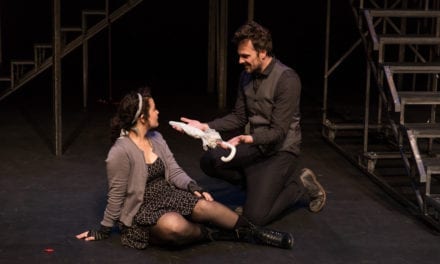PROVO — Romeo and Juliet is the second of a summer-long double feature from Utah Shakespeare in the Park (the first was Much Ado About Nothing, in June). And, while Romeo and Juliet is an enjoyable evening of theater—how can an outdoor production of a Shakespeare classic be anything else?—it does have its problems.
Meg Fee, as Juliet, is definitely the standout in the cast. Her poise, confidence, and emotional authenticity help keep the show alive (even if she does look a bit mature to be playing a 14-year-old). Cameron Bench, as Romeo, is not as finely trained an actor as his co-star, but he brings much of the same energy and conviction—and the two leads have enough chemistry to make the classic romance feel genuinely romantic (something far too rare in the many Romeo and Juliet productions I’ve seen). Lawrence Fernandez, playing dual roles as Lord Capulet and Friar Laurence, is the other highlight of the cast. Though not all of Fernandez’s choices with either of these characters worked for me, he has a commanding presence, an excellent sense of physicality, and a strong voice (he even sings briefly—a nice little rendition of “Strangers in the Night”). His dedication to the material and the production is palpable.
Where the play suffers most is in the direction. The key to Shakespeare tends to be in the language, and the cast had a general problem of rushing over their lines. The blocking, too, is often sloppy, and the actors rarely make clear choices in their use of their space; as a result, it’s sometimes hard to know where to look. The sparse set is made up of two black blocks—but, strangely, those blocks are almost never used. Some of the actors speak in affected English accents; most don’t. The use of a guitar player and a violinist for musical underscoring allowed for a few of the very best moments in the show, but too often the musicians came across as timid, as if unsure when they should or shouldn’t be playing.
There are a handful of modernizations sprinkled throughout the show—a handgun in the midst of a swordfight, the inclusion of a Lady Gaga song at the Capulets’ party, etc.—but these moments are rare, and, consequently, a little jarring. There are also a number of unorthodox interpretations and adaptations of the script, which worked to varying degrees. I was excited, for instance, to see Mercutio played by a woman, but disappointed when the character wasn’t explored much beyond that. I found the juxtaposition of the two scenes where Juliet and Romeo each learns of his banishment (playing them simultaneously, as if cross-cut for film) quite moving and effective. On the other hand, the affair between Lady Capulet and Paris felt rather out of place (and, rather than providing additional motivation for Lady Capulet’s character, it instead turned her into some of a one-dimensional villainess).
Ultimately, Utah Shakespeare in the Park’s Romeo and Juliet feels like it’s not entirely sure what it wants to be–a rather traditional production of a well-known classic, or a bold new reinterpretation. There are a lot of good ideas, and a number of obviously talented people involved, but there doesn’t seem to be any overarching concept or vision to tie everything together. Too often, the choices on the part of the actors or director feel unmotivated, unclear, or uncommitted—and, because of that, it was sometimes hard for me to commit as an audience member. Still, while at times uneven, there’s lots to like in this Romeo and Juliet—and any show where I can sit in the grass and eat dinner while I’m watching is a show I want to be at.





